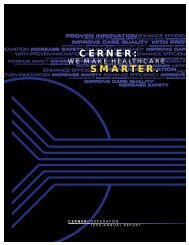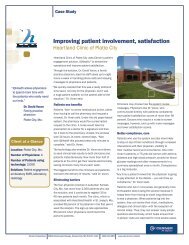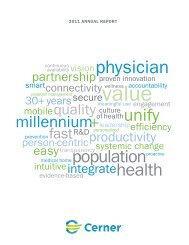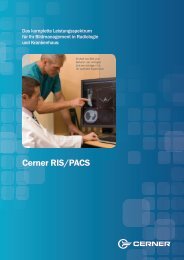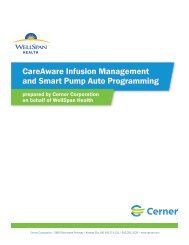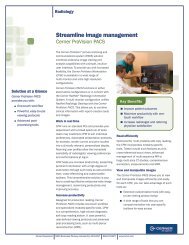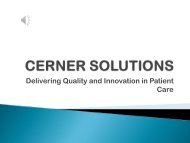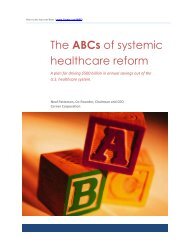The ABCs of systemic healthcare reform - Cerner Corporation
The ABCs of systemic healthcare reform - Cerner Corporation
The ABCs of systemic healthcare reform - Cerner Corporation
- No tags were found...
Create successful ePaper yourself
Turn your PDF publications into a flip-book with our unique Google optimized e-Paper software.
(1) Summary <strong>of</strong> Significant Accounting Policies<br />
(a) Principles <strong>of</strong> Consolidation<br />
<strong>The</strong> consolidated financial statements include the accounts <strong>of</strong> <strong>Cerner</strong> <strong>Corporation</strong> and its wholly-owned subsidiaries (the<br />
“Company”). All significant intercompany transactions and balances have been eliminated in consolidation.<br />
(b) Nature <strong>of</strong> Operations<br />
<strong>The</strong> Company designs, develops, markets, installs, hosts and supports s<strong>of</strong>tware information technology, <strong>healthcare</strong> devices and<br />
content solutions for <strong>healthcare</strong> organizations and consumers. <strong>The</strong> Company also provides a wide range <strong>of</strong> value-added<br />
services, including implementing solutions as individual, combined or enterprise-wide systems; hosting solutions in its data<br />
center; and clinical process optimization services. Furthermore, the Company provides fully–automated on-site employer health<br />
clinics and third party administrator health plan services for employers.<br />
(c) Revenue Recognition<br />
Revenues are derived primarily from the licensing <strong>of</strong> clinical, financial and administrative information systems and solutions.<br />
<strong>The</strong> components <strong>of</strong> the system sales revenues are the licensing <strong>of</strong> computer s<strong>of</strong>tware, deployment period upgrades, installation,<br />
content subscriptions, transaction processing and the sale <strong>of</strong> computer hardware and sublicensed s<strong>of</strong>tware. <strong>The</strong> components<br />
<strong>of</strong> support, maintenance and service revenues are s<strong>of</strong>tware support and hardware maintenance, remote hosting and managed<br />
services, training, consulting and implementation services. For arrangements that include both product and services which are<br />
accounted for under SOP 81-1 and also include support services (PCS) for which vendor-specific objective evidence <strong>of</strong> fair value<br />
(VSOE) <strong>of</strong> PCS does not exist such that a zero margin approach is used to recognize revenue, the Company classifies revenue<br />
under such arrangements as either systems sales or support, maintenance and services based on the nature <strong>of</strong> costs incurred.<br />
For similar arrangements for which VSOE <strong>of</strong> PCS exists, PCS is separated from the arrangement based on VSOE and the residual<br />
amount is allocated to the s<strong>of</strong>tware and services accounted for on a combined basis under SOP 81-1. For these arrangements,<br />
the service component <strong>of</strong> the SOP 81-1 deliverable is classified as service revenue based on the VSOE <strong>of</strong> the services as if<br />
provided on a stand-alone basis and the residual is classified as systems sales revenue. For the years ended January 3, 2009,<br />
December 29, 2007 and December 30, 2006, approximately $26,700,000, $20,000,000 and $16,000,000, respectively, <strong>of</strong><br />
revenue were included in system sales and approximately $86,600,000, $95,000,000 and $55,000,000, respectively, <strong>of</strong><br />
revenue were included in support, maintenance, and services for such arrangements. <strong>The</strong> Company provides several models<br />
for the procurement <strong>of</strong> its clinical, financial and administrative information systems. <strong>The</strong> predominant method is a perpetual<br />
s<strong>of</strong>tware license agreement, project-related installation services, implementation and consulting services, s<strong>of</strong>tware support and<br />
either remote hosting services or computer hardware and sublicensed s<strong>of</strong>tware.<br />
<strong>The</strong> Company recognizes revenue in accordance with the provisions <strong>of</strong> Statement <strong>of</strong> Position (SOP) 97-2, “S<strong>of</strong>tware Revenue<br />
Recognition,” as amended by SOP 98-4, SOP 98-9 and clarified by Staff Accounting Bulletin’s (SAB) No. 104 “Revenue<br />
Recognition” and Emerging Issues Task Force Issue No. 00-21 “Accounting for Revenue Arrangements with Multiple<br />
Deliverables” (“EITF 00-21”). SOP 97-2, as amended, generally requires revenue earned on s<strong>of</strong>tware arrangements involving<br />
multiple-elements to be allocated to each element based on the relative fair values <strong>of</strong> those elements if fair values exist for all<br />
elements <strong>of</strong> the arrangement. Pursuant to SOP 98-9, the Company recognizes revenue from multiple-element s<strong>of</strong>tware<br />
arrangements using the residual method. Under the residual method, revenue is recognized in a multiple-element arrangement<br />
when Company-specific objective evidence <strong>of</strong> fair value exists for all <strong>of</strong> the undelivered elements in the arrangement (i.e.<br />
pr<strong>of</strong>essional services, s<strong>of</strong>tware support, hardware maintenance, remote hosting services, hardware and sublicensed s<strong>of</strong>tware),<br />
but does not exist for one or more <strong>of</strong> the delivered elements in the arrangement (i.e. s<strong>of</strong>tware solutions including project-related<br />
installation services). <strong>The</strong> Company allocates revenue to each undelivered element in a multiple-element arrangement based<br />
on the element’s respective fair value, with the fair value determined by the price charged when that element is sold separately.<br />
Specifically, the Company determines the fair value <strong>of</strong> the s<strong>of</strong>tware support and maintenance, hardware and sublicensed<br />
s<strong>of</strong>tware support, remote hosting and subscriptions portions <strong>of</strong> the arrangement based on the substantive renewal price for<br />
these services charged to clients; pr<strong>of</strong>essional services (including training and consulting) portion <strong>of</strong> the arrangement, other<br />
than installation services, based on hourly rates which the Company charges for these services when sold apart from a s<strong>of</strong>tware<br />
license; and, the hardware and sublicensed s<strong>of</strong>tware, based on the prices for these elements when they are sold separately<br />
from the s<strong>of</strong>tware. <strong>The</strong> residual amount <strong>of</strong> the fee after allocating revenue to the fair value <strong>of</strong> the undelivered elements is<br />
attributed to the s<strong>of</strong>tware solution, including project-related installation services. If evidence <strong>of</strong> the fair value cannot be<br />
established for the undelivered elements <strong>of</strong> a license agreement, the entire amount <strong>of</strong> revenue under the arrangement is<br />
deferred until these elements have been delivered or objective evidence can be established.<br />
<strong>The</strong> Company provides project-related installation services, which include project-scoping services, conducting pre-installation<br />
audits and creating initial environments. Because installation services are deemed to be essential to the functionality <strong>of</strong> the<br />
s<strong>of</strong>tware, the Company recognizes the s<strong>of</strong>tware license and installation services fees over the s<strong>of</strong>tware installation period using<br />
the percentage <strong>of</strong> completion method pursuant to Statement <strong>of</strong> Position 81-1 (SOP 81-1), Accounting for Performance <strong>of</strong><br />
Construction-Type and Certain Production-Type Contracts, as prescribed by SOP 97-2. <strong>The</strong> Company measures the percentage<br />
<strong>of</strong> completion based on output measures which reflect direct labor hours incurred, beginning at s<strong>of</strong>tware delivery and<br />
culminating at completion <strong>of</strong> installation. <strong>The</strong> installation services process length is dependent upon client specific factors and<br />
generally occurs in the same period the contracts are executed but can extend up to one year.<br />
63



